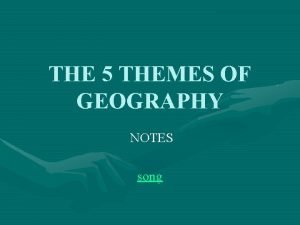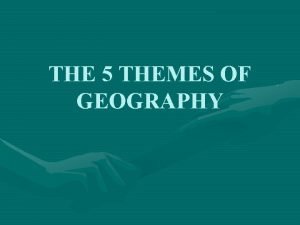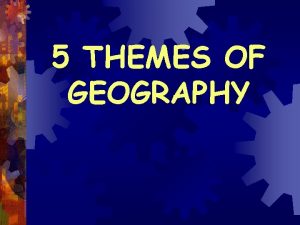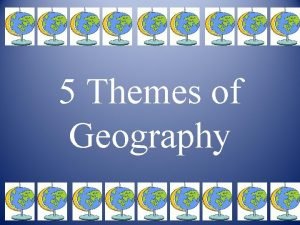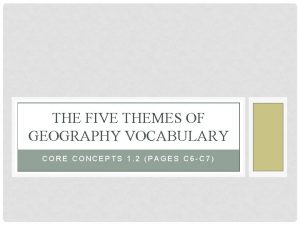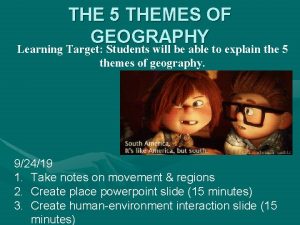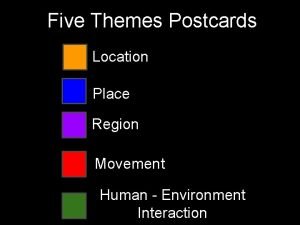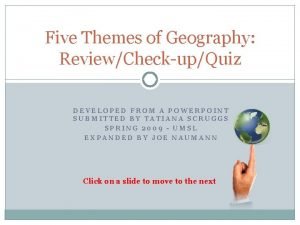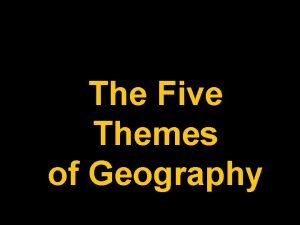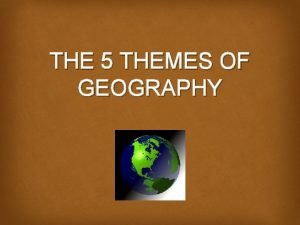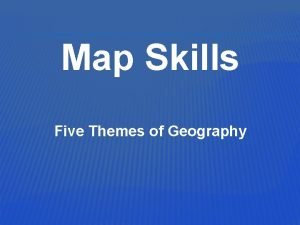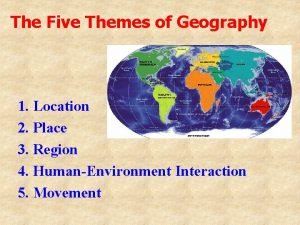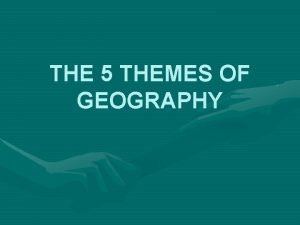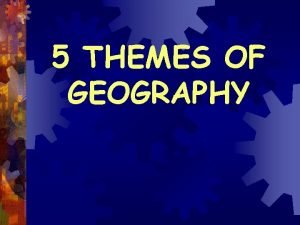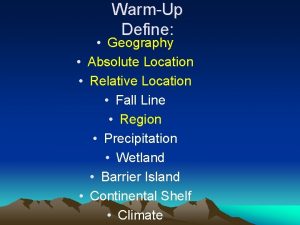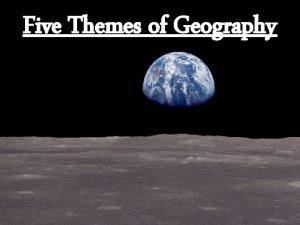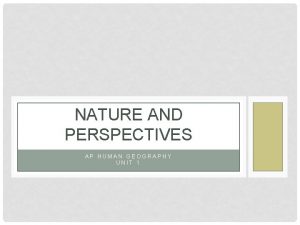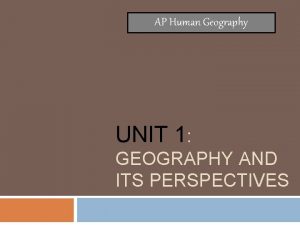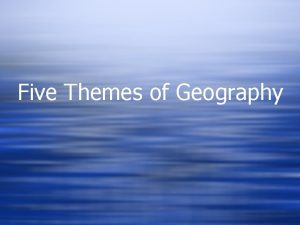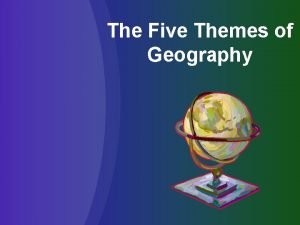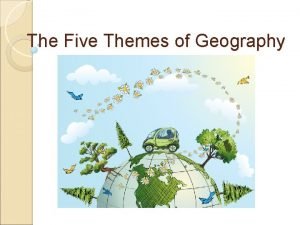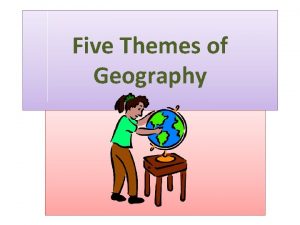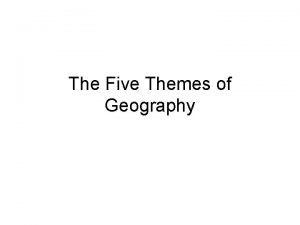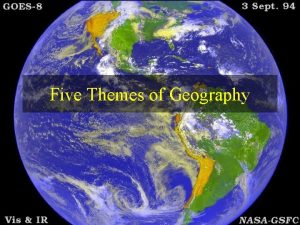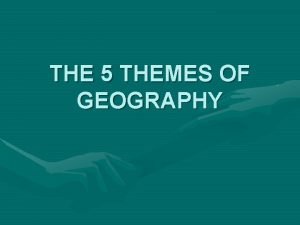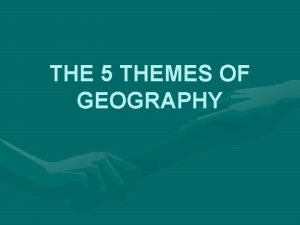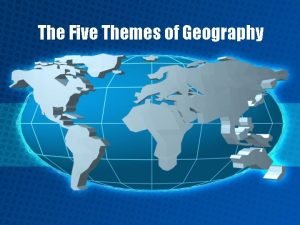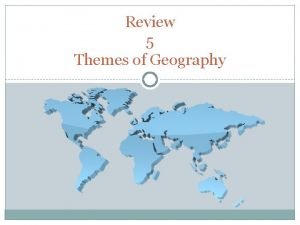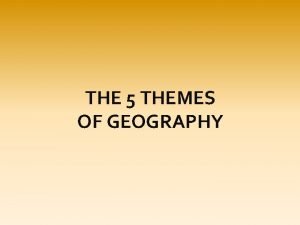The Five Themes of Geography 1 Location 2
























- Slides: 24

The Five Themes of Geography 1. Location 2. Place 3. Human-Environment Interaction 4. Movement 5. Regions

Theme 1: Location • Where is It? • Why is It There? Two Types of Location • Absolute • Relative

Absolute Location • • A specific place on the Earth’s surface Uses a grid system Latitude and longitude A global address

Absolute Location - Longitude • Measured in degrees E or W of the Prime Meridian (0° - runs through Greenwich, England) • 0° and 180° do not use direction • The distance between lines of Longitude is larger towards the Equator and they converge at the poles

Absolute Location - Longitude 35 miles 69 miles

Absolute Location - Latitude • Measured in degrees N or S of the Equator (0° runs around the “center” of the globe) • North Pole = 90° N South Pole = 90° S • 0° does not use direction • The distance between all lines of Latitude is equal – Each degree is approximately 69 miles

Absolute Location Latitude and Longitude are measured in: Degrees ° - Minutes ’ - Seconds ” Great Valley High School • Latitude 40°N 3’ 26. 40” • Longitude 75°W 34’ 3. 14”

Relative Location • Where a place is in relation to another place • Often uses directional words to describe – Cardinal and intermediate directions

Relative Location • The United States is bordered to its NORTH by Canada and to its SOUTH by Mexico • The Atlantic Ocean forms the US EAST coast and the Pacific Ocean its WEST coast. • The United States is in the WESTERN HEMISPHERE • The US is in NORTH AMERICA

Theme 2: Place • Place describes the human and physical characteristics of a location.

Theme 2: Place Physical Characteristics • Physical characteristics include a description such things as the mountains, rivers, beaches, topography, and animal and plant life of a place.

Theme 2: Place Human Characteristics • Human characteristics include the humandesigned cultural features of a place, from land use and architecture, to forms of livelihood and religion, to food and folk ways, to transportation and communication networks.

Theme 3: Human Environment Interaction How People Interact With Their Environment People. . . • Adapt to Their Environment • Modify Their Environment • Depend on Their Environment

Pennsylvania: Human Environment Interaction • Adapt To Their Environment • Kinzua Dam – Allegany Forest

Pennsylvania: Human Environment Interaction • Modify Their Environment • Schuylkill Canal - Phoenixville

Pennsylvania: Human Environment Interaction • Depend on Their Environment • Amish Farmer in Lancaster

Theme 3: Human Environment Interaction This can also result in NEGATIVE results

Theme 4: Movement The Mobility of • People • Goods • Ideas How Places are linked to one another and the world

Pennsylvania: Movement

Theme 5: Regions What Places Have in Common • Political Regions • Landform Regions • Agricultural Regions • Cultural Regions

Theme 5: Regions • Political Regions

Theme 5: Regions • Landform • Regions

Theme 5: Regions • Agricultural Regions

Theme 5: Regions • Cultural Regions SEC Big 10
 5 themes of geography location definition
5 themes of geography location definition 5 things of geography song
5 things of geography song France 5 themes of geography
France 5 themes of geography List the five themes of geography
List the five themes of geography Five themes of geography definition
Five themes of geography definition Five themes of geography poster
Five themes of geography poster Five themes of geography vocabulary
Five themes of geography vocabulary Five themes of geography notes
Five themes of geography notes Five themes of geography definition
Five themes of geography definition Aspects of geography
Aspects of geography What is the theme of movement
What is the theme of movement Five themes of geography quiz
Five themes of geography quiz Poniferous
Poniferous 5 themes
5 themes Movement five themes of geography
Movement five themes of geography 5 themes of geography mexico
5 themes of geography mexico Five themes of geography definition
Five themes of geography definition Place 5 themes of geography definition
Place 5 themes of geography definition 5 themes of geography ap human geography
5 themes of geography ap human geography A cross country skier moves from location a to location b
A cross country skier moves from location a to location b Chapter 8 location planning and analysis
Chapter 8 location planning and analysis Blue ridge region
Blue ridge region Location
Location Cartogram definition ap human geography
Cartogram definition ap human geography Mathematical location definition ap human geography
Mathematical location definition ap human geography

